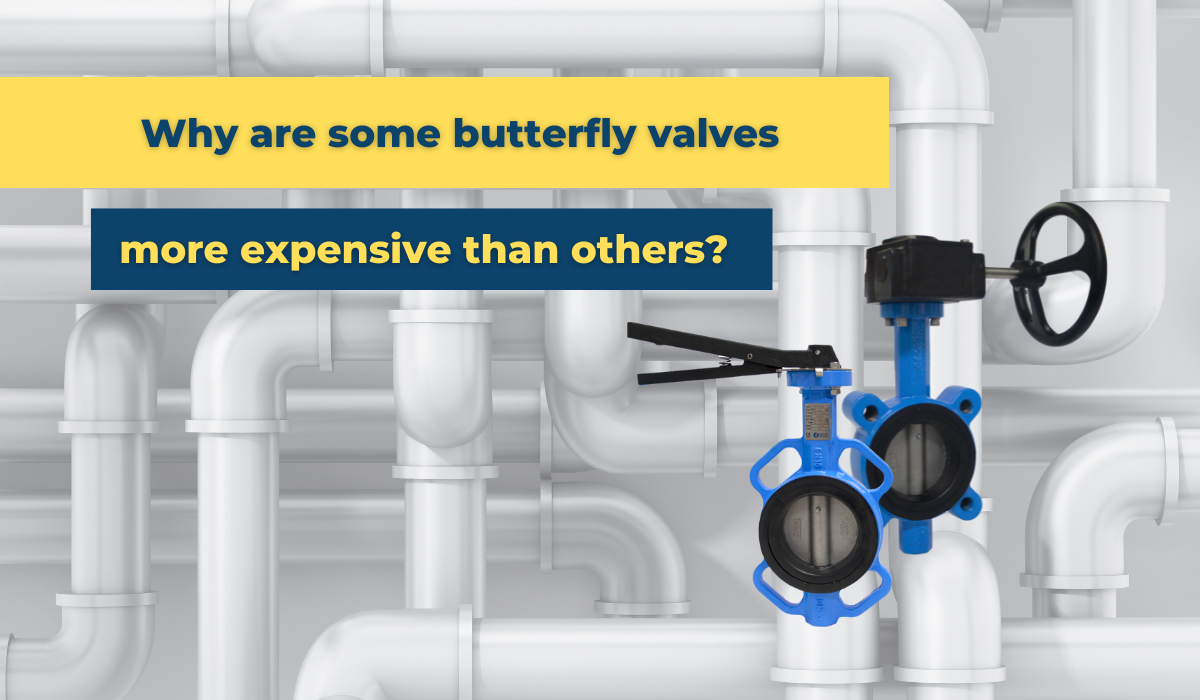Why are some butterfly valves more expensive than others?
When looking for butterfly valves in New Zealand, it can be difficult to determine why some are more expensive than others, as they may appear similar at first glance. However, the price difference is generally dependent on the materials used to manufacture them, and the type of valve you need.
In this article, we break down the various features of butterfly valves and explain the factors that contribute to their varying prices.
Two types of butterfly valves
A butterfly valve regulates the flow of liquid or gas in a pipe by rotating a disc to open or close the flow path. It is characterised by a circular disc that rotates on a shaft to control the flow. This design is a simple and economical solution for applications where a tight shut-off is not required. There are two types of butterfly valves available – wafer type and lugged type.
Wafer butterfly valves
These are used for general installations, particularly for isolation or flow control within a pipe. Typically, they are mounted between two flanges with flange bolts passing through the complete assembly. When tightened, this pulls the whole assembly together. They have clearance holes solely to locate the valve during installation.
However, the main drawback of these valves is that any maintenance work will require a system shutdown.
Lugged butterfly valves
The main differences with a lugged valve are that each flange bolt has a lug to tighten it, and there is a separate bolt on each side. This means the bolts are much shorter and you can remove either of the adjacent pieces of piping while the system is still in operation.
This is achieved with two different sets of bolts, one attached to each of the adjoining flanges. One bolt set is dismantled for cleaning or maintenance, while the second set forms a strong seal between the valve and the remaining piece of pipe.
This means the valve can either be installed at the end of the line or in a pipeline that is disassembled periodically. If it’s the latter, the valve can be left bolted on one side to avoid emptying the upstream or downstream pipelines when they are removed.
What affects the cost of a butterfly valve?
The main features that affect the cost of a butterfly valve are the materials of construction and the quality of design.
Valve body
Most butterfly valves are made with a cast iron body, but there are different types and qualities of casting to choose from. The most common options are grey cast iron and ductile iron.
Grey cast iron valve bodies:
Grey cast iron valve bodies are known for their strength, durability and affordability. They have a high resistance to wear and corrosion, making them ideal for use in harsh environments.
Grey cast iron is easy and inexpensive to produce, making it a more cost-effective choice.
Advantages:
-
Strong
-
Heat, vibration and wear resistant
-
Good machinability
-
Low cost
Disadvantages:
-
The molecular structure of graphite flakes, making it brittle and inflexible
-
Low tensile strength
-
Low elongation percentage
-
Low corrosion resistance
Ductile iron
Made with nodule-shaped graphite, ductile iron is extremely durable. It has high impact resistance, tensile strength and elongation percentage, along with corrosion resistance. This makes it a suitable choice for many high-demand applications.
Due to its complex chemical makeup, ductile iron is more expensive to manufacture than grey cast iron. However, if your application demands strength and durability, the extra investment will be worthwhile.
Advantages:
-
High impact resistance
-
Durable
-
High tensile strength
-
High elongation percentage
-
Higher corrosion resistance
-
Withstands high pressure and temperature
Disadvantages:
-
Low machinability
-
High cost
Disc
The disc material will also have an impact on the overall cost of your butterfly valve. Common options include:
-
Cast iron
-
Aluminium bronze
-
Cast stainless steel
Cast iron is usually the more affordable option but the longevity of cast stainless steel may be worth the higher upfront cost. Most valve manufacturers use cast stainless steel CF8M which is a thicker version of SS316, known for its high corrosion resistance and versatility.
Shaft
Most shafts are made of stainless steel but the grades do vary in terms of wear resistance, crevice corrosion and longevity. For example, 300 Series stainless steel is less expensive than the 400 Series but doesn’t have the same durability.
Shaft bushing
It is designed to reduce wear and vibration and is usually made of a low-friction material, including:
-
Brass
-
Bronze
-
High-grade composite plastic
Modern high-grade plastics like PTFE can outperform traditional metals in terms of wear resistance and longevity.
Fasteners, notch plate, and lever handle spring
The fasteners, notch plate and lever handle spring will also impact the overall cost of a butterfly valve. Typically, these parts are made of one of the following materials:
-
Zinc-plated steel
-
Stainless steel 304
-
Stainless steel 316
Stainless steel 316 is more expensive but its longer life expectancy is usually worth the extra cost. It should be considered for marine and coastal applications where the valve is subject to the elements.
Valve seat materials
When closed, the disc presses against the valve seat, or liner, to create a seal. The valve seat should be made of a durable material that is resistant to corrosion and pressure. Most valve manufacturers offer a range of valve seat materials, including the following:
EPDM
Ethylene Propylene Diene Monomer (EPDM) is a synthetic rubber with excellent weather resistance and flexibility. It is relatively inexpensive and suitable for water applications, high pressure, and temperatures between -20°C to +120°C. EPDM is typically used in systems processing drinking water, heating/cooling (HVAC), steam and firefighting. It is not suitable for oils or hydrocarbons.
Nitrile
Nitrile (NBR) is a synthetic rubber known for its resistance to oils, fuels and most chemicals. It is also durable and able to withstand temperatures from 0°C to more than 80°C. Nitrile is a cost-effective choice for many applications, especially considering its resistance to weather, flames and heavy impacts. It is often used in systems processing oils, fuel, and certain chemicals.
Viton
Viton (FKM) is another type of synthetic rubber known for its chemical resistance and high-temperature tolerance of -20°C to +180°C. Compared to EPDM and NBR, this is a more expensive material. Viton is used in systems processing such as hot water, solar, oils, hydrocarbons, compressed air, oxygen, and a wide range of acids and solvents. It is not suitable for ethers, ketones, bases, and in most cases, steam.
Type of valve seat
In addition to the material of the valve seat, there are three seat configurations to choose from – booted dovetail, moulded and cartridge.
Booted dovetail seat
This valve seat is created with a ‘dovetail’ shape that matches the diameter of the valve's inner body. This is easier to remove and service because the seat is not bonded. However, this also means it can easily deform or bulge around contact points on the disc. This may lead to frequent replacements.
Moulded seat
With a moulded valve seat, the seat and the valve body are bonded together. This is more cost-effective, versatile and less susceptible to deformation. However, if damage does occur, the entire valve will need to be replaced, rather than just the damaged piece.
Cartridge seat
For a cartridge valve seat, an elastomer layer is compressed onto a phenolic backing ring. This provides support for the elastomer when the valve moves in various directions. Cartridge seats provide excellent wear resistance, torque consistency and resistance to deformation. The seat is replaceable if damage does occur, however, the cartridge design is more expensive than the alternatives.
Additional factors
In addition to the above considerations about parts and materials, the following factors will also affect the cost, functionality and longevity of your valve:
External coating: The thickness and corrosion resistance of the coating will directly affect the valve's life expectancy. It may be worth investing more in this extra layer of protection.
Pressure rating: Due to the quality of materials required to manufacture them, valves with higher pressure ratings typically come at a higher cost. This will depend on the casting material, thickness and design.
Mounting flange: Does the valve have a mounting flange to enable the use of a gearbox operator or electric/pneumatic actuator? It should be compliant with ISO5211.
Design Standards and Certifications: Does the valve comply with the necessary regulations? For example, Standards EN593 and BS5155 as well as Watermark, DVGW, DNV, Lloyds Register and WRAS.
Conclusion
The price of butterfly valves can vary due to the quality of materials and design. To make an informed choice for your specific needs, it's wise to consider all the contributing factors, not just the upfront cost.
At Waterworks, our team is always happy to help you with any questions or concerns, ensuring you get the most value from your equipment. Browse our range of butterfly valves or contact us for specialist advice today.



.png?width=352&name=WW%20best%20valve%20for%20wastewater%20and%20effluent%20(1).png)

-1.png?width=352&name=WW%20%20Blog%20headers%202023%20(3)-1.png)